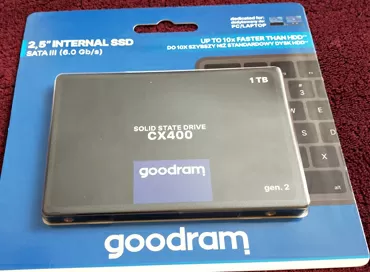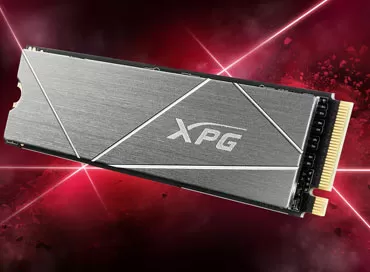SSD Crucial P5 Plus 1TB review: testing by office workloads
Micron is one of the few vertically integrated brands, which means that the company develops and manufactures controllers, cache and memory chips for its drives. In the retail market, Micron drives are sold under the Crucial brand, and in conditions of fierce competition, they are often lost against the background of their competitors using more aggressive marketing. From a technical point of view, Crucial drives have proven to be very reliable solutions.
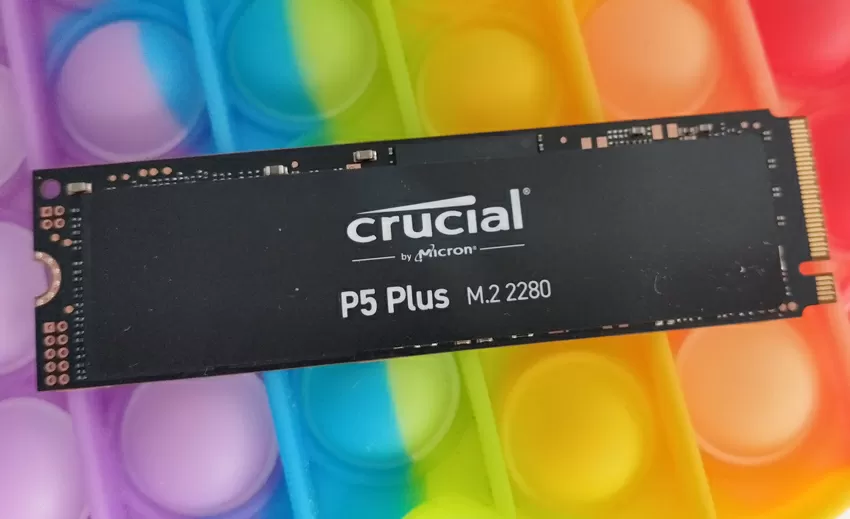
Today we have on the NVME M.2 test the P5 Plus model with a volume of 1 TB, belonging to the average price range. This drive is interesting because it supports PCI Express 4.0 bus, has 1 GB of onboard LPDDR4 memory, has a built-in power saving system (APST, Autonomous Power State Transition), a new 8-channel 6-core DM02A controller.1 and 176-layer Micron 3D TLC memory. For workloads, it also matters that the drive is protected from data loss in case of a sudden power outage at the time of recording, which is achieved by data recording algorithms, and not by adding super capacitors, as in some server models.
The Crucial P5 Plus drives use two Micron B47R 176L TLC memory chips with a claimed performance of 1600 MT/s. Compared to 96-layer TLC memory, these chips have 30% less core area, lower resistance, lower read and write delays with higher reliability. For a 1-terabyte modification, a write resource of 600 TB is declared. To increase reliability, Micron has developed RAID technology (Redundant array of independent NAND) - the use of redundancy by analogy with RAID, but within a single drive. To protect against unauthorized access, AES-256 hardware full-disk encryption is supported (compatible with OPAL 2.0 and Windows Bitlocker specifications) and Secure Erase data deletion (read our article about comparing data disposal methods).
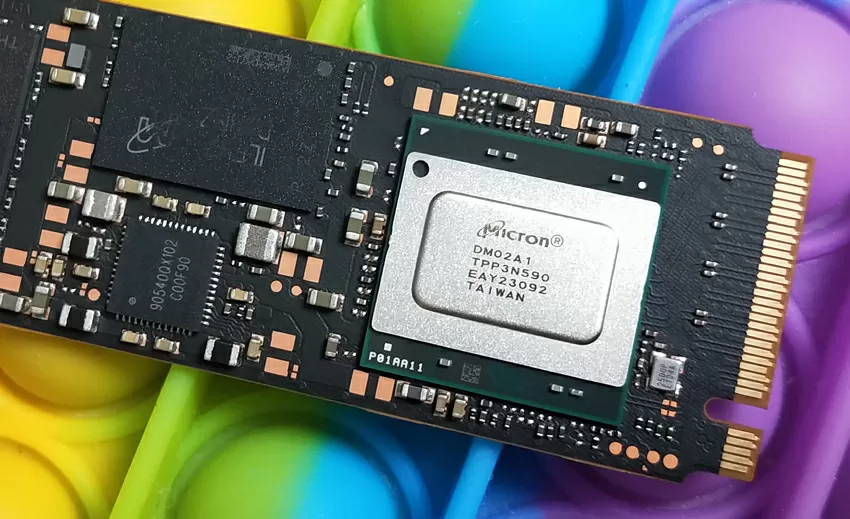
To protect against overheating, an adaptive mechanism is used that allows the drive to heat up as much as 80 degrees Celsius, and perhaps this technology allowed the manufacturer to abandon the built-in radiator, replacing it with a paper sticker that causes only one desire - to tear it off as soon as possible. Of course, almost all modern motherboards have good built-in cooling for M.2 slots, with the exception of models for workstations, servers, as well as some monoblocks and laptops. Well, as they say, there is no problem to buy a radiator on Aliexpress, especially since the installation on the Crucial P5 Plus is only on the front side.
Software
From the manufacturer's website, you can download the Storage Executive program, through which it is convenient to update the firmware, monitor S.M.A.R.T. and monitor the status of the disk. If the Crucial P5 Plus disk is bootable, you can enable additional write caching (Momentum Cache) for it, which will give you up to 4 GB of extra cache under Windows. It is also possible to configure Over provisioning to increase responsiveness under heavy load. By the way, for most gaming / office tasks it is not necessary to do this - the drive is initially configured for optimal performance.
Testing
We do not use the CrystalDisk Benchmark, because the results obtained by this test package are synthesized in order to show the theoretical maximum of an SSD drive. In real life, they do not occur in desktop and server tasks, and it is impossible to focus on them. Our task is to show what the speed of the drive will be at any given time, how significant the failures are and how the cache works when filling up space.
For testing, we will use the IOmeter package, with which we will fill 750 GB of storage space with random data. We will conduct each test in three variants: for 100%, 10% and 1% of the required 750 GB. In this case, we will see the degradation of speed in write operations, and we will be able to see how caching of read operations works. Since both SSDs are models for desktop computers, we will use 1-thread testing in patterns for office tasks. Each of the tests will be run for 300 seconds, with a break of 600 seconds between tests. As a metric, we will take the response time - a real indicator of how much SSD speeds up the application (the smaller it is, the better), as well as bandwidth, since it is more familiar to many. For comparison, we will use the recently tested budget SSD ADATA Gammix S50 Lite, with four 96-layer NAND chips and an SM2267 controller. Let's start with the simplest test - sequential access in blocks of 2 MB.
In read operations, the Crucial P5 Plus drive shows performance at the level from 2 to 2.35 GB/s, it is at this speed that simple file copying can be performed in Windows.
The recording clearly shows how differently the controllers of different drives work. With a decrease in the workspace, the Crucial P5 Plus does not experience a drop in speed, but exactly the opposite - the disk reaches maximum performance in the region of 3 GB / s, the write speed to NAND chips is quite high throughout the test, and although there are no such huge failures as A data XPG S50 Lite here. Let's move on to random operations with a transaction size of 4K.
Random reading is clearly not the strongest side of the Crucial P5 Plus, and we see some acceleration due to predictive reading only on a test volume limited to 1.7 GB.
But random recording, on the contrary, is given to the drive perfectly, and throughout the entire testing time, performance is stable, without blockages.
Well, let's move on to the patterns taken from real tasks.
Capture One performs batch processing of photos, implementing simultaneous reading and writing processes. And according to the test results, you should pay attention to the first minute of the test. With simultaneous reading and writing, the speed of the SSD decreases over time, but at least the Crucial P5 Plus had a big one. Depending on the test area, the drive could process from 25 to 100 GB of data at speeds above 2 GB/s, which is more than enough for real-world applications.
With the mixed reading characteristic of opening a 4K video file, the Crucial P5 Plus experiences a significant decrease in speed compared to the synthetic reading test.
And this picture is confirmed by the test of checking backups - at any size of the area, well, except for the smallest at 1%.
Diluting a complex pattern with a large number of random read operations, we see that the picture is preserved.
And in the diametrically opposite case, when saving backups on an SSD, there is no pronounced picture. In small recording areas, the Crucial P5 Plus steers, but in general, only a multithreaded test is missing to complete the picture..
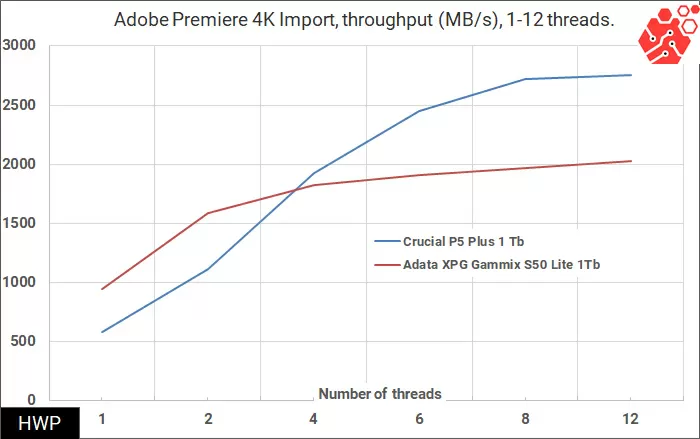
According to the test results, we see a smooth increase in speed up to 8 in terms of the number of controller cores, after which a further increase in the number of threads does not lead to an increase in speed. For comparison, the 4-type layout of A data Games S50 on a 4-channel controller has a higher speed at 1-4 streams, but then it blows away.
Conclusions
The 1 TB Critical P5 Plus drive has a 2-type layout on an 8-core controller with a dedicated DRAM cache. I would say that such a design would be great for server-side multithreaded applications if the disk was positioned for databases and virtualization systems. In the usual 1-thread mode typical of games or CG applications, it performs very well on short loads while caching is running. Yes, it is better implemented here than in the drives of previous generations, and practically if you do not work with files of tens of gigabytes, then this drive will always give you high speed at the level of 1-2.5 GB/s, as well as a delay of less than 1 ms. This is a very high speed, significantly ahead of the capabilities of modern CPU and graphics programs.
The second point that deserves attention is the minimum speed at which the disk "falls" in intensive read/write operations. It often happens that an SSD can show several GB per second according to tests, and work at a speed of 40-60 MB / s, which is simply catastrophic. Our test Crucial P5 Plus in tests of real tasks did not fall below 270 MB/s, and in synthetics it was more balanced around its average speed: without unnecessary ups and downs.
In general, the Crucial P5 Plus has no contraindications, and can be used for absolutely any tasks, including games, content creation, software development and work with office applications. If you choose desktop drives for server tasks (containers, virtualization, databases, NAS caching), then I would say that this is one of the best options for sane money.
Michael Degtjarev (aka LIKE OFF)
20/10.2021










